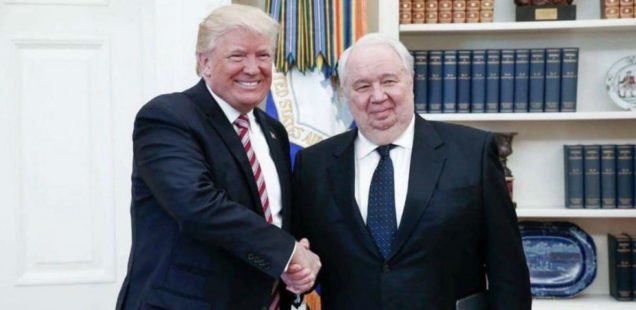
Trump Does Have Real Connections to Russia—and Here’s Why
When President Trump handed foreign policy over to his generals a few weeks ago, his plans for a new détente with Russia were dead in the water, and Secretary of State Tillerson was more or less out of the picture.
That was then. As of Wednesday, when Trump and Tillerson held separate talks in Washington with Sergei Lavrov, Russia’s foreign minister, improved ties with Moscow are back on the table, and Tillerson appears to hold the U.S.–Russia portfolio.
Donald Trump’s Washington is nothing if not a hard, erratic read.
Related: From Xi to Duterte: Why Trump Holds His Enemies Closer
It’s too soon to conclude that Lavrov’s visit—the first by a Russian cabinet minister since Trump took office—marks a decisive turn. But the early signs are it will. That would be a major victory for Trump and begin a fundamental shift in the confrontational Russia policy the Obama administration handed him.
“Why now?” is the question. No one on Team Trump is saying, but the most logical answer is that Trump sees a chance to keep his two most consistent promises in one shot: Let’s destroy ISIS, and let’s put relations with Moscow on a more constructive footing.
This means one thing as of this week: The proving ground for Trump’s new try for détente is Syria. That’s unfortunate for the White House: Syria is the toughest, messiest, trickiest crisis Trump faces, but it’s also the most pressing.
It’s Syria, in fact, that seems to have influenced Trump to revive his long and consistent ambition to improve ties to Russia. First came Trump’s May 2 telephone conversation with President Putin—“a very good one,” the White House said afterward. A day later the administration announced it was sending an envoy to the peace talks in the Kazakhstani capital that Russia co-sponsors with Turkey and Iran.
Related: Trump’s Next Challenge: Russia Returns to Afghanistan
Those talks, which began in January, are the most promising effort to date to forge a political solution in Syria after seven years of failed attempts. In the May 3–4 round, the three co-sponsors committed to guaranteeing four “de-escalation zones” on Syrian soil.
Diplomatic contacts between Moscow and Washington have been thick and fast ever since.
Trump, Tillerson, and Lavrov made a couple of important things clear after their talks Wednesday. One, Lavrov studiously avoided any mention of the sanctions the Obama administration imposed on Russia after it annexed Crimea in 2014. Moscow knows it stands zero chance of getting them lifted as things now stand, so they’re not on Russia’s quid pro quo list.
Two, Trump’s looking for “broader cooperation” across a range of issues. That’s a clear signal—to Moscow and his adversaries in Washington both—that he’s going for full-dress détente, not just a one-off effort in Syria.
But Syria could hardly be a tougher place to start. Here are the Trump administration’s four big challenges:
Related: Here’s the Real Puzzle About the Trump-Russia Connection
• It’s Moscow, not the U.S., that’s leading the current peace process, and Iran’s among the guarantors of the “de-escalation zones.” If the U.S. joins in, as Russia wants it to, it will give Moscow the kind of global credibility Obama refused to proffer. It will also put the U.S. in a distant but unmistakable alliance with Tehran. How will all this go over on Capitol Hill?
• The three-page agreement signed in Astana last week, bars all third parties from military activity in the zones, and Russian diplomats have been clear that this includes the U.S. It means the Pentagon has to cooperate with any agreement Trump and Tillerson reach in coming days. And don’t forget: The Pentagon scuttled John Kerry when he was Obama’s secretary of state and tried to established military-to-military “deconfliction.”
• Russia is now charged with keeping the Syrian army and the Iranians under control, and chances are it will: Moscow wants this fire out. More daunting is whether the U.S. can influence the “moderate” rebels it supports since it never has — some of them walked out of the Astana talks last week.
Related: Trump Meets Russia Foreign Minister Amid Comey Controversy
• As of Tuesday, the U.S. is now arming Kurdish forces in the fight for Raqqa, headquarters of ISIS. It’s an instant challenge to the U.S. alliance with Turkey, which bombed the same Kurdish forces just two weeks ago. Are Trump and Tillerson up to sorting through the unprecedented complications that ties to Ankara bring the U.S.?
It’s hard to see just what led up to Trump’s second chance to renovate relations with Russia. But there’s no mistaking that he’s serious: As Lavrov left the Oval Office, in came none other than Henry Kissinger, the father of détente during the Brezhnev years. Trump can pull this off, but only if people from a lot of Washington constituencies are on his side.
Should he? Without question. Get Syria right, and much else awaits. First on the list is the Ukraine crisis, which the Obama administration showed no capacity whatever to manage sensibly. That’s likely to come up if Trump, as Russian media reported Thursday, meets Putin during a Group of 20 sessions in Hamburg this summer.

